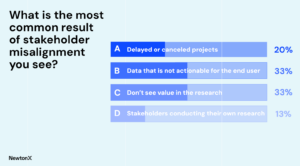Jimmy Coonan: “One of the things you’ve said that stuck with me is this good enough mindset. I know the market, I know the customer. I can keep moving in the right direction. How have you seen that be a common cause of misalignment?”
Pamela Sufi: “In smaller firms, there’s a huge pressure to show results quickly, right? So I just need enough to know if I’m going the right direction and then I’ll figure it out over time. And at larger firms, there’s a mindset of—as long as I’m not going in the opposite direction, I just keep progressing and generating revenue—building the product, whatever it is—it’s good enough. There’s a lot of silos and people don’t have to work together. So what one person needs for their job—product management, product development, marketing, whomever—it’s like, “I know enough to do what I need to do.”
Jimmy Coonan: “And both are detrimental to the research process, absolutely.”
How to solve for stakeholder misalignment challenges
Structural differences, budget considerations, and a lack of shared understanding on the value of research: these all lead to consequences for the data. We polled insights leaders below on common results of stakeholder misalignment:

Get rid of the “Good Enough” mindset
A common cause of misalignment is the “good enough” mindset. The pressure to show quick results may lead stakeholders to believe that they only need enough information to ensure they are heading in the right direction. This leads to working in silos—and limiting the depth and quality of research—decreasing its impact.
Communicate ROI and value to in your stakeholders’ languages
It’s crucial to tailor language on the return on investment (ROI) of research across stakeholders. Different stakeholders may perceive the value differently based on their goals. For instance, a marketer might see lead generation potential, while product management might find value in validating the direction of their initiatives.


